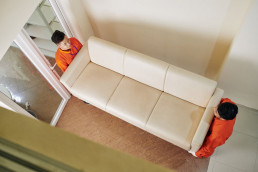Moving home or office can present significant challenges. Whether you are moving from one flat to another or changing your business space, you can relax in the knowledge that a professional removal company will handle the relocation safely. But even removal specialists have to protect themselves from potential accidents. In this blog post, we discuss the risks involved in a move and show you how you can sufficiently protect yourself as a private individual or a removal company employee. We will also explain your rights during the relocation process.
Risks of accidents during moves
Every year, around 4.8 million households move home. That’s a lot of relocations, which all involve a range of hazards – every year, around 2.8 million people are injured at home. Furthermore, around 8,000 people are fatally injured at home every year, compared to around 3,500 people who are killed in road accidents. Your home might be harbouring a few more dangers than you are aware of! During a move, the risk of an accident within your own four walls increases dramatically. That’s because a space that is normally tidy and organised is now full of unstable cardboard boxes, disassembled furniture – the individual parts of which pose a trip hazard – and a whole host of small household items strewn across the floor. Most moves involve going up and down flights of stairs, or at least a few steps. If these are very steep, narrow, uneven, slippery or winding, even a trained furniture remover can easily stumble, resulting in a dangerous fall. Constantly going up and down with heavy boxes and furniture gets tiring quickly, and flagging strength and energy can result in you or your helpers having a fall, even on non-slip, level stairs. The risk of falls is a hazard that must be taken seriously: every year, 3,363 people out of every 100,000 people are injured in a fall.

Whether you are a private individual or a removal company, it is important to look after the health of your furniture removers. Are your employees or helpers fit enough for a move? Which of the people involved can carry the particularly heavy boxes and furniture, and who should limit themselves to the lighter items? You should ask these questions before your move. As a fundamental rule, cardboard boxes should never be packed too full, and must not weigh more than 20 kilograms – or preferably no more than 15 kilograms. It is better to pack a few more boxes that weigh less rather than fewer boxes that weigh so much that the furniture removers end up with a slipped disc, torn ligament or trapped nerve. If you are unlucky enough to suffer one of these injuries, that will be the end of the move for you – recovery can take from 6 weeks up to several months. Evidently, safety measures must not be neglected.
However, the dangers inherent in a move are present long before you start moving boxes around: there are plenty of risks involved even when first disassembling furniture and packing. Furniture often puts up a fight when you try to disassemble it, which can quickly lead to your hands or feet slipping. Impact injuries are also common during house moves – if individual parts of furniture are balanced precariously, these can slip or fall over at the slightest touch. If your head is in the way, it will take the brunt of the blow, and in the worst-case scenario this could lead to concussion. For this reason, always make sure that you arrange boxes and objects in a way that will prevent accidents.
Protective clothing for relocations
If you run a removal company, you will most likely already have equipped your employees with appropriate protective clothing. However, private individuals rarely think about the clothing they should wear for moving furniture around when helping with house moves: safety is generally given almost no thought in this context. However, suitable safety gloves are crucial during a move. These will give your hands a safe grip, protect them from abrasions and help them make it through a hard day of removals without a scratch. Many items or parts of furniture have sharp edges or a smooth surface that is difficult for the hand to grip. The handle holes in cardboard boxes are very uncomfortable for the hands and may cut into the palms. With safety gloves, you can hold everything securely, and there’s no need to worry about injuries to the palms of your hands or grazed fingers. If you’re concerned that wearing safety gloves will mean you have less feeling in your fingers, meaning that the gloves will be a hindrance to your work rather than a help, think again. This may be the case with many safety gloves, unfortunately, but there are exceptions. Take the uvex Bamboo TwinFlex® D xg, for example – thanks to the practical Bamboo TwinFlex technology, you will maintain optimal sensitivity, and the safety gloves will feel like a second skin in just a few minutes. Whether you’re making calls on your smartphone or ticking off items on your moving checklist – all of this is possible thanks to the touchscreen capability of the uvex Bamboo TwinFlex® D xg. Thanks to their optimal skin compatibility, confirmed by dermatologists, uvex safety gloves can be worn throughout the entire moving day without causing irritation.

During a move, you are on your feet the entire day – and they take a lot of strain. That’s why a safety shoe should be a core part of your equipment. This shoe should have a penetration-resistant sole that offers optimal shock absorption and returns energy to the wearer. This makes every step you take a little lighter, conserving your energy. The metal-free protective toe cap, which protects your toes from falling objects or boxes, makes the uvex 1 G2 shoe suitable foot protection for anyone working in removals. An integrated steel cap in the safety shoe offers all-round protection for your foot and toes. In addition, the uvex 2 trend features a uvex anti-twist heel cap, which significantly increases protection against ankle twists. A helmet is a good way to protect your head from falling items and boxes. The uvex pheos IES sits comfortably thanks to variable width adjustment, and three air vents provide the required ventilation while your head remains protected.
Of course, it’s also important to choose wisely when it comes to the rest of your clothing for the move: avoid wearing clothes that are too loose and that could get caught, and instead choose comfortable clothes that will not impede your work moving furniture around. The everyday protective clothing from uvex suXXeed and uvex collection 26 is particularly flexible and therefore offers optimal freedom of movement. This clothing is certified in line with OEKO-Tex® Standard 100 and features practical pockets for holding tools, a smartphone, or a folding rule as well as cooling ventilation zones that make it pleasant to wear all day long.
Insurance cover & rights when moving
Moving home or relocating your company always takes a great deal of time and effort – time that as a professional you generally don’t have to spare. No one wants to take holiday leave for a move, however, and special paid leave is unfortunately only an option if you are relocating for work. The German Civil Code does not stipulate a right to special leave in any other cases – unless there are other grounds laid out in your employment contract. In the case of a company relocation, the main concern is ensuring that employees will be able to carry out their work without interruptions, or at least that any downtime will not cause significant loss. To ensure that your move goes without a hitch, it’s a good idea to use the checklist for company relocations as a guide and ideally follow it step by step. For private moves, too, a checklist is always helpful.

It is particularly important to consider possible insurance before starting the moving process. After all, who is going to cover the costs if something gets broken in transit? The German Civil Code clearly states that anyone who causes damage is liable to pay for it. If the person who causes the damage is helping with the move in a private capacity, this falls under the heading of an ‘act of good will’. These are favours done by a friend who is not compensated for his or her help – for example helping with a move or house-sitting while you are on holiday. Cases such as these are covered by personal liability insurance. If an insured party damages an object during the move, their personal liability insurance pays compensation for the damage. If the person responsible for causing the damage does not have personal liability insurance, the German Civil Code states that they do not have to pay compensation – unless the damage was caused deliberately.
If you are planning to transport particularly valuable items such as works of art, kitchen furniture, musical equipment etc., you should consider goods in transit insurance. Depending on the type of goods in transit insurance you choose, this covers any damage that arises during the transportation of your possessions. This insurance is particularly valuable to business owners who are planning the relocation of their company as it provides financial protection for expensive hardware and high-value furnishings.
But who is liable when a person rather than an object is harmed? As we have already seen, moving comes with a huge number of potential risks for those assisting with the move. However, if you injure yourself while helping with a relocation, and the injury is caused by your own actions rather than those of the person moving, then you yourself are liable for any costs involved. In this case, personal accident insurance is a good idea. In Germany, around 26.08 million people over 14 years of age consider personal accident insurance to be necessary and have taken it out. Unlike statutory accident insurance, personal accident insurance also covers accidents that happen at home, in the garden and in your spare time – anywhere around the world. Independent contractors and freelancers, homemakers and retired people can take out personal accident insurance to cover all their requirements. This type of insurance also covers accidents that happen while working from home.
You may feel that you are in safe hands if you hire a removal company because they will have all the required insurance and be covered for every eventuality – and this is true to a certain extent, of course. According to German law, however, the amount of compensation a removal company must pay in the event of damage is limited to 620 euros per cubic metre. In addition, removal companies usually do not assume any liability for items that have not been packed by their own employees to professional standards. That’s why it’s best to book a comprehensive package for your move and do some careful reading about what is not insured according to the contract – you can then take appropriate measures in good time and insure your possessions.
How many times have you relocated? Does your removal company already have all the required protective equipment? We would be delighted to help you make the right choice when it comes to clothing for your move and to give you detailed information about our products. Tell us about your experiences of moving as a removal company or a private person in the comments – we can’t wait to hear your stories.
Sources:
https://de.statista.com/statistik/daten/studie/503482/umfrage/verletzte-und-getoetete-in-haus-und-freizeit-nach-unfallhergang-in-der-schweiz/
https://www.deutsche-familienversicherung.de/sachversicherung/hausratversicherung/ratgeber/artikel/die-meisten-unfaelle-passieren-zu-hause/
https://de.statista.com/statistik/daten/studie/266247/umfrage/versicherungen-besitz-einer-privaten-unfallversicherung-in-deutschland/